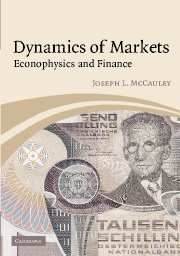Book contents
- Frontmatter
- Contents
- Preface
- 1 The moving target
- 2 Neo-classical economic theory
- 3 Probability and stochastic processes
- 4 Scaling the ivory tower of finance
- 5 Standard betting procedures in portfolio selection theory
- 6 Dynamics of financial markets, volatility, and option pricing
- 7 Thermodynamic analogies vs instability of markets
- 8 Scaling, correlations, and cascades in finance and turbulence
- 9 What is complexity?
- References
- Index
4 - Scaling the ivory tower of finance
Published online by Cambridge University Press: 31 October 2009
- Frontmatter
- Contents
- Preface
- 1 The moving target
- 2 Neo-classical economic theory
- 3 Probability and stochastic processes
- 4 Scaling the ivory tower of finance
- 5 Standard betting procedures in portfolio selection theory
- 6 Dynamics of financial markets, volatility, and option pricing
- 7 Thermodynamic analogies vs instability of markets
- 8 Scaling, correlations, and cascades in finance and turbulence
- 9 What is complexity?
- References
- Index
Summary
Prolog
In this chapter, whose title is borrowed from Farmer (1999), we discuss basic ideas from finance: the time value of money, arbitrage, several different ideas of value, as well as the Modigliani–Miller theorem, which is a cornerstone of classical finance theory. We then turn our attention to several ideas from econophysics: fat-tailed distributions, market instability, and universality.We criticize the economists' application of the word “equilibrium” to processes that vary rapidly with time and are far from dynamic equilibrium, where supply and demand certainly do not balance. New points of view are presented in the two sections on Adam Smith's Invisible Hand and Fischer Black's notion of “equilibrium.” First we will start with elementary mathematics, but eventually will draw heavily on the introduction to probability and stochastic processes presented in Chapter 3.
Horse trading by a fancy name
The basic idea of horse trading is to buy a nag cheaply and unload it on someone else for a profit. One can horse trade in financial markets too, where it is given the fancy name “arbitrage.” Arbitrage sounds more respectable, especially to academics and bankers.
The idea of arbitrage is simple. If the Euro sells for $1.10 in Frankfurt and $1.09 in New York, then traders should tend to short the Euro in Frankfurt and simultaneously buy it in New York to repay the borrowed Euros, assuming that transaction costs and taxes are less than the total gain (taxes and transaction costs are ignored to zeroth order in theoretical finance arguments).
- Type
- Chapter
- Information
- Dynamics of MarketsEconophysics and Finance, pp. 63 - 90Publisher: Cambridge University PressPrint publication year: 2004



